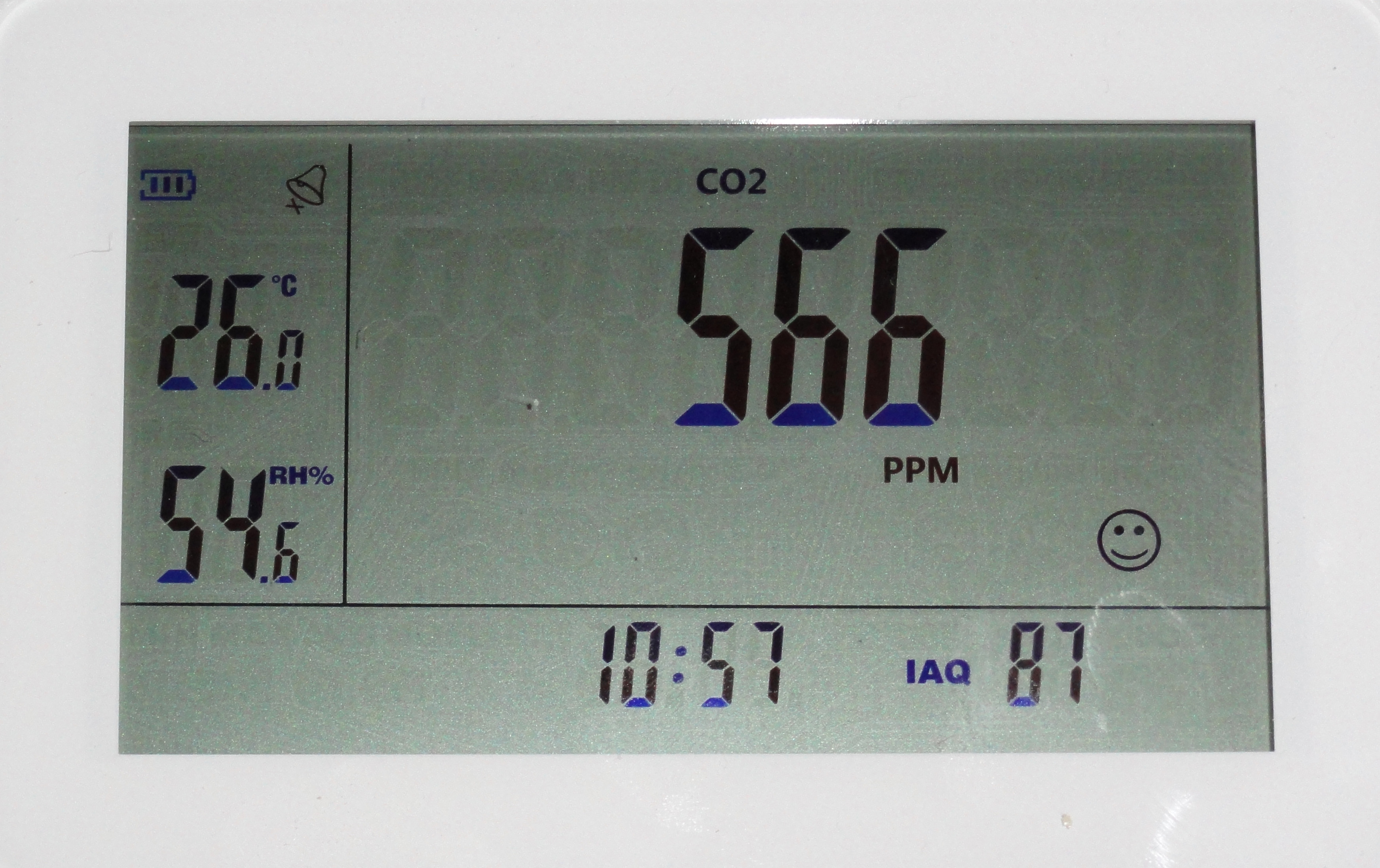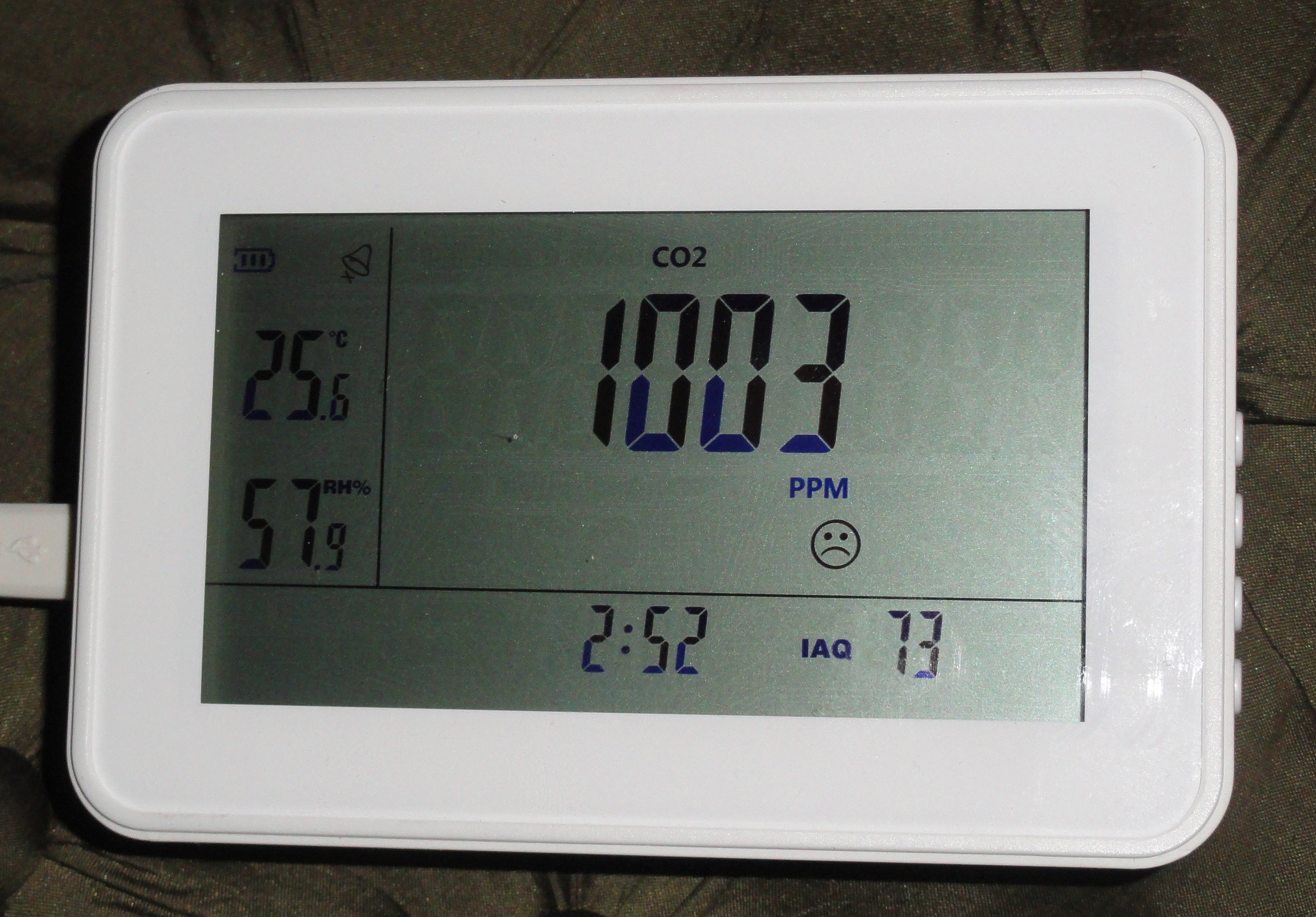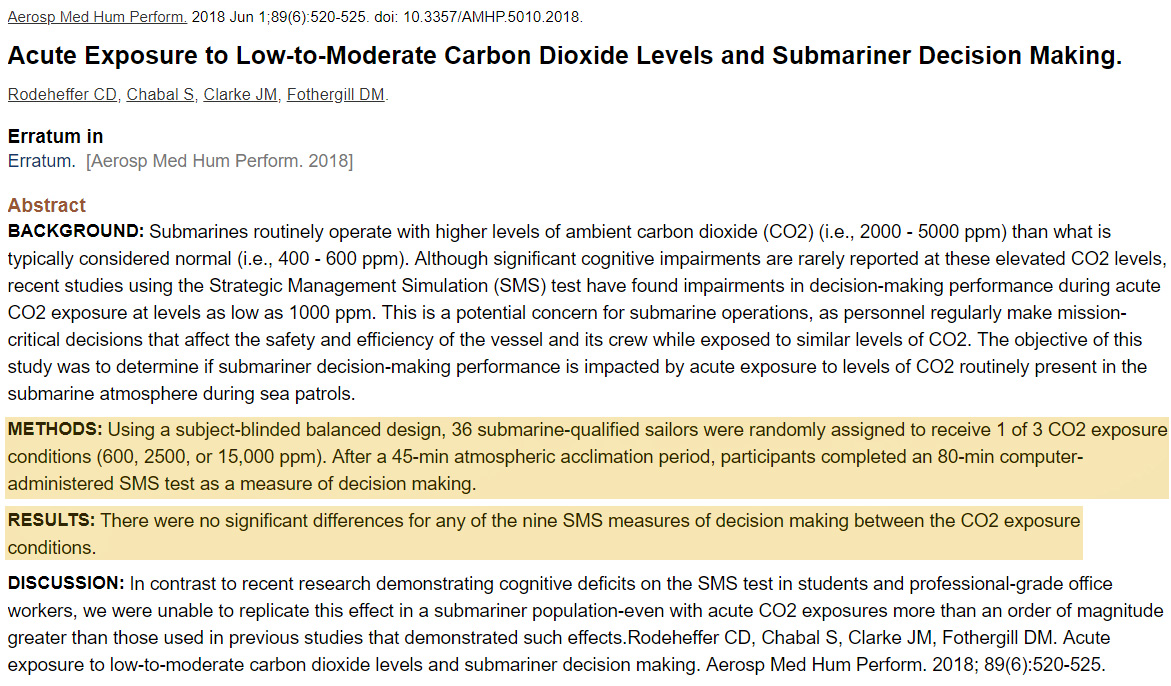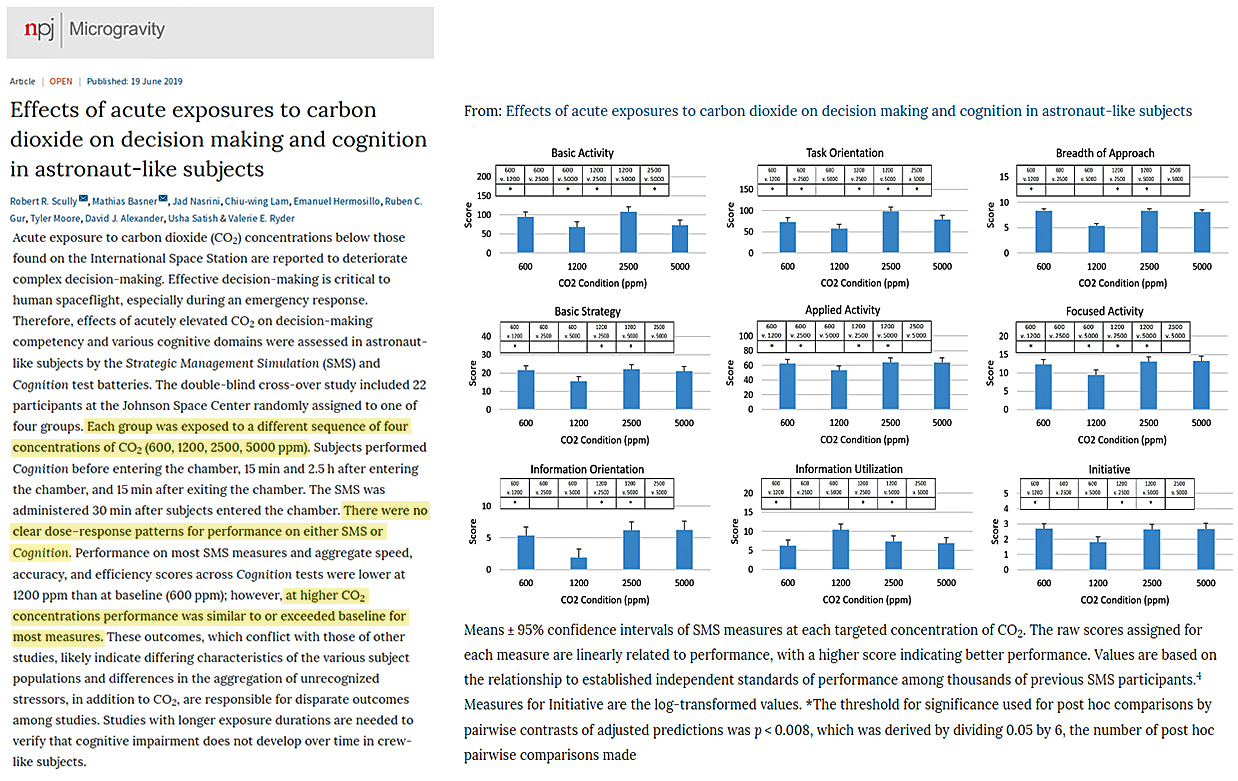A new paper finds the performance of test-taking (cognitive, decision-making) “astronaut-like” subjects exposed to 5000 ppm CO2 was “similar to or exceeded” the performance of those exposed to baseline (600 ppm). This study follows up on a 2018 paper that determined submariners exposed to 15000 ppm CO2 performed just as well as subjects exposed to 600 ppm.
Those of us who own CO2 monitors know that indoor (bedroom) CO2 concentrations typically vary between about 600 ppm during the day and 1000 ppm overnight – the latter earning a frowny face air quality rating.


CO2 is a cognitively-impairing toxin?
In recent years there has been a push to create the impression carbon dioxide is a pollutant, or toxin. Consequently, there have been a few studies suggesting exposure to higher CO2 concentrations (~1500 to 2500 ppm) severely impair human cognitive and decision-making performance (Satish et al., 2012, Allen et al., 2016).
If true, this would be rather problematic for elementary school children, as they are routinely exposed to CO2 concentrations ranging between about 1500 and 3000 ppm in their classrooms (Corsi et al., 2002).
Driving alone in one’s vehicle could mean exposure to “3700 ppm … above outdoor [CO2] concentrations” (Satish et al, 2012), or about 4100 ppm.
This elevated-CO2-is-toxic-to-brain-functioning paradigm suggests the world’s highways are teeming with cognitively-impaired drivers.
2 new studies show elevated CO2 has no effect on cognitive performance
The results from a 2018 study (Rodeheffer et al., 2018) measuring the cognitive and decision-making performances of submariners exposed to elevated CO2 undermined the attempts to portray CO2 as a brain-function-impairing toxin.
In the study, subjects were exposed to 3 CO2 conditions: 600, 2500, and 15000 ppm.
The results indicated there were “no significant differences” in how the subjects performed for any of the CO2 exposure levels.

Image Source: Rodeheffer et al., 2018
A new study (Scully et al., 2019) assessing the capacity of elevated CO2 exposure to affect cognitive and decision-making performance appends the Rodeheffer et al. (2018) results.
This time, “astronaut-like” subjects were exposed to four CO2 gradients: 600, 1200, 2500, and 5000 ppm.
The results indicated there were “no clear dose-response patterns” evident for any of the exposure conditions.
In fact, the performance of subjects exposed to 5000 ppm slightly exceeded the performance of subjects exposed to 600 ppm CO2.
These results suggest the elevated-CO2-is-toxic-to-brain-functioning paradigm is not supported by real-world experiments.






I spent months on a submarine with CO2 so high (and oxygen so low) that cigarettes wouldn’t stay lit (this was back in the not-so-long-ago bad old days when smoking was still allowed on submarines). At the end of it, just before we came off station, cigarette lighters wouldn’t even light.
Our oxygen generator had broken, our oxygen candles were all used up, we were on station (off Kamchatka where the military base was, where we weren’t supposed to be) and couldn’t ventilate, and our CO2 scrubber was on the fritz.
No problems at all cognitively, although when we did finally get out of there and came to periscope depth to ventilate, that air smelled so sweet it almost made me cry. Air in a submarine tends to get a bit rank over time. What with the monoethylamine from the scrubbers, and the oil mist from the reduction gears (although the electrostatic precipitators were supposed to catch it all, they didn’t), you come off a long op smelling like dog crap and grease, all zitty from the grease and MEA… you had to wash your clothes three times and shower three times to get the smell out.
My home for about 3 1/2 years.
https://www.navysite.de/ships/as18.htm
I never went out in a sub, but was aboard a few briefly in port. Always regretted not volunteering for subs, instead of serving on a tender. Anyway, it was good. Besides, too late now for a redo.
People work in commercial greenhouses with elevated CO2 levels (up to twice normal atmospheric levels, some up to 1000ppm) and temperatures quite comfortably.
Modern buildings with their no draft, sealed-up designs quite often have CO2 levels reaching twice the atmospheric levels when filled with people.
Also as this shows https://earth.nullschool.net/#current/chem/surface/level/overlay=co2sc/orthographic=3.56,46.75,1821 for CO2 concentration does not mirror the temperatures, https://earth.nullschool.net/#current/wind/surface/level/overlay=temp/orthographic=3.56,46.75,1821 .
Meanwhile yesterday in Guardianlalaland
“Indoor carbon dioxide levels could be a health hazard, scientists warn
CO2 in bedrooms and offices may affect cognition and cause kidney and bone problems”
https://www.theguardian.com/environment/2019/jul/08/indoor-carbon-dioxide-levels-could-be-a-health-hazard-scientists-warn
“Dr Gary Fuller, an air pollution scientist at King’s College London, said his team had been measuring CO2 levels in London for the past decade. While levels rarely reached 1,000ppm, he said, they often exceeded 750ppm along busy roads. “Unless we decarbonise heating and transport then these peaks will worsen as the global background increases,” he said.”
Why would CO2 levels be high in a room be high in a room packed with people
..who are all BREATHING ..and expiring CO2 ?
The effect is well known that is why architecture plans spcify ventilation as important
..and occasionally health problems show up when there is not enough.
FFS why does the Guardian think this is NEW ?
Why does the Guardian then quoter Fuller talking about OUTDOOR
Wonder what levels does CO2 get to in intense greenery say in daytime forest or marshland ?
Is it an NEW actual study
No, it’s a meta study,. seemingly these days where you cherrypick studies that support your pre-existing narrative and try to make great claims.
\\ Writing in the journal Nature Sustainability, Hernke and colleagues report that they considered 18 studies of the levels of CO2 humans are exposed to, as well as its health impacts on both humans and animals.//
The Guardian article is short
.. and #3 doesn’t allow open comments .. that’s a red flag
#4 Is it PR or news .. Like the Times they chose to use the PR trick of using a sepia like photo to make it look scary.
Apollo 13 CO2 did hit some limit where astronauts showed symptoms. Not sure (pressure not known), but a report mentioned 60,000ppm.
The old report was here
https://www.jsc.nasa.gov/history/mission_trans/AS13_TEC.PDF
but now I cannot connect.
https://www.hq.nasa.gov/alsj/a13/AS13_TEC.PDF
seems to work. Full transcript, page down to about 384.
Partial pressure as high as 15mm Hg (@ 03 13 22 14)
In a regular (760mm Hg) air pressure, that’d be close to 20,000 ppm
But they didn’t pressurise to standard atmosphere.
Physiologically, CO2 starts to become toxic at about a partial pressure of 10-20 ppm (pCO2 – 10-20)in the blood stream and respiration increases to reduce it; at a pCO2 = 40, it is irreversibly lethal. Don’t know how that relates to environmental ppm, but the poor guys on a submarine!!! Oh, my!
Not sure where you’re getting your information, BobW, but…
https://www.ncbi.nlm.nih.gov/books/NBK482268/
.
Can’t be lethal in a healthy person if it’s normally 40-45 for him.
Do you have an online reference for what you cited?
Of course the study is correct, and for well established fundamental reasons.
Humans maintain a body CO2 concentration of 20,000 ppm. To maintain this concentration, the volume of respiration varies. If CO2 rises, minute volume rises. If it falls, minute volume falls. Until the ambient CO2 is close to 20,000 ppm there will be no cognitive impairment.
As an aside, you breathe primarily to get rid of CO2, only secondarily to get oxygen.
[…] by K. Richard, July 8, 2019 in NoTricksZone […]
Driving alone in one’s vehicle could mean exposure to “3700 ppm … above outdoor [CO2] concentrations”
Since I always have the vents pointing directly at my face, the only time I’m not breathing outside air is if the recirculation facility is turned on. That will only be for a short time and a very good reason – such as following a really dirty older diesel…
[…] https://notrickszone.com/2019/07/08/scientists-humans-perform-as-well-or-better-when-exposed-to-high… […]
[…] https://notrickszone.com/2019/07/08/scientists-humans-perform-as-well-or-better-when-exposed-to-high… […]
[…] Scientists: Humans Perform As Well Or Better When Exposed To High (5000-15000 ppm) vs. Low CO2 Conce… […]
[…] https://notrickszone.com/2019/07/08/scientists-humans-perform-as-well-or-better-when-exposed-to-high… […]
[…] https://notrickszone.com/2019/07/08/scientists-humans-perform-as-well-or-better-when-exposed-to-high… […]
So we all become submarine-trained personal or astronaut-like … problem solved. Can’t they test with a general population group performing normal decision making?
They really don’t. It just shows you can get mixed result depending on setup of the experiment. Or are you saying all the studies that clearly showed the problem of elevated CO2 are fake?
That being said, the outdoor concentration will probably never reach any level that would pose this kind of problem in the near future mankind influenced CO2 concentration development.